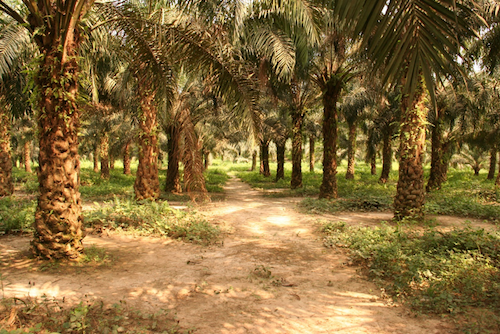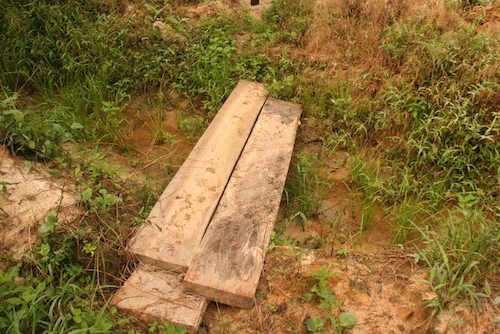Sustainable Oil Palm Farming / Harvesting paths and access
| |
Download: Module 3: Plantation Maintenance
Contents
Goal
- Create good access into the plantation for all management activities
- Enable fast and easy harvesting
Standard
- Paths are between 50—75 cm wide
- Paths are completely free of weeds
- One path is present every other palm row (see Figure 16)
- Plantations are easy to access (e.g. footbridges over ditches and swamps, no steep slopes, etc.)
- Harvesters with heavy wheelbarrows can move around the plantation easily
Timing
- At the beginning and end of the dry period
- Shortly before the peak season (so harvesting can be done more efficiently)
- Not when rain is expected that day (otherwise the herbicide is washed away)
- Usually done together with circle weeding
Frequency
- Once every 3—4 months, or;
- Whenever the weeds on the path are above ankle height
Labour time required
- Manual weeding: 2 days per hectare
- Chemical weeding: together with circle weeding, 1 day per 2 hectares
- Bridges, ramps, etc.: depending on the condition of the plantation
Equipment and materials
- Manual weeding:
- - Chisel / spade
- - Bush knife
- Chemical weeding:
- - Knapsack sprayer
- - Protective clothing
- - Measuring cup (50—200 ml)
- - Clean water (50—100 L/ha)
- - Herbicide (0.5—2 L/ha)
Who
Farmers and their families or hired labourers
How
Manual weeding of paths
To manually weed paths:
- Cut down all weeds on the path to ground level with a bush knife or scrape away all weeds using a spade
- If possible, pull out woody weeds with large roots. If they cannot be pulled out, dig out the stumps with a chisel or spade
Chemical weeding of paths
For tall weeds (more than 50 cm) start with one round of manual weeding and then spray the young re-growing weeds after one month or when the weeds are at ankle height using the following procedure:
| Step 1. | Make sure the sprayer is calibrated and working properly. |
| Step 2. | Prepare the herbicide according to the instructions on the package (see also Storing and spraying chemicals). |
| Step 3. | Select a nozzle that gives a spray of about half a meter wide. |
| Step 4. | Spray the path using the following technique:
Per hectare, expect to spray 50 to 100 L of solution (0.5 to 2 L of herbicide), depending on the number of weeds and the instructions on the label. See Removing noxious weeds for information on how to kill woody weeds. |
Installing foot bridges and ramps
- All harvesting paths should lead to a main path (or: ‘collection road’) which is accessible for a car, truck or heavily loaded motorbike
- If there are ditches or canals that need to be crossed install foot-bridges which are:
- - Strong and solid (will not collapse when a harvester with a full wheelbarrow walks over it)
- - At least 20 cm wide (best to use a wide plank or several planks attached together)
- - Well attached on both sides and not moving or wobbling (see Figure 17)
- If there are steep slopes:
- - Dig out a ramp where a harvester with a heavy wheelbarrow can pass easily
- - Put a wooden plank over the ramp to prevent it from getting too slippery
Data recording
Every weeding or maintenance activity should be recorded in a logbook as shown in the example below.
| Date | Time | Location | Activity | Input type | Input amount | Input costs | Labour input | Labour costs | |
| People | Hours | ||||||||
| 16/01/13 | Field 3 | Path and circle weeding | Round-Up | 1 L | 75000 | 1 | 8 | 80000 | |
Acknowledgements
The material from Harvesting paths and access is sourced from Smallholder Oil Palm Handbook and put together by Lotte Suzanne Woittiez (Wageningen Universit) and Haryono Sadikin, Sri Turhina, Hidayat Dani, Tri Purba Dukan, and Hans Smit (SNV) in August 2016. See Module 3: Plantation Maintenance for more information.




